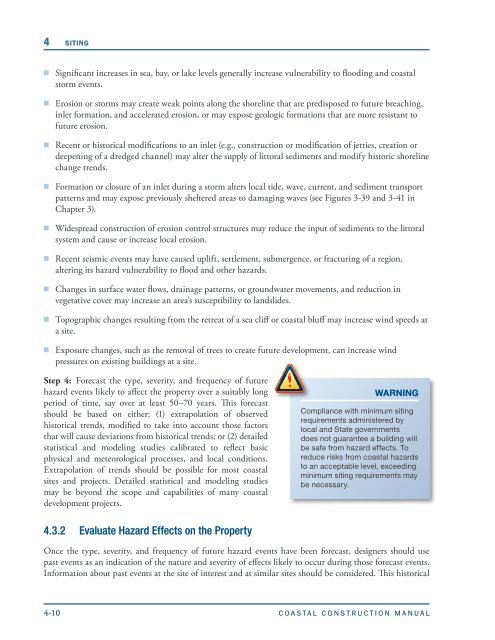Coastal Construction Manual - National Ready Mixed Concrete ...
Coastal Construction Manual - National Ready Mixed Concrete ...
Coastal Construction Manual - National Ready Mixed Concrete ...
Create successful ePaper yourself
Turn your PDF publications into a flip-book with our unique Google optimized e-Paper software.
4 SITING<br />
<br />
Significant increases in sea, bay, or lake levels generally increase vulnerability to flooding and coastal<br />
storm events.<br />
<br />
Erosion or storms may create weak points along the shoreline that are predisposed to future breaching,<br />
inlet formation, and accelerated erosion, or may expose geologic formations that are more resistant to<br />
future erosion.<br />
<br />
Recent or historical modifications to an inlet (e.g., construction or modification of jetties, creation or<br />
deepening of a dredged channel) may alter the supply of littoral sediments and modify historic shoreline<br />
change trends.<br />
<br />
Formation or closure of an inlet during a storm alters local tide, wave, current, and sediment transport<br />
patterns and may expose previously sheltered areas to damaging waves (see Figures 3-39 and 3-41 in<br />
Chapter 3).<br />
<br />
Widespread construction of erosion control structures may reduce the input of sediments to the littoral<br />
system and cause or increase local erosion.<br />
<br />
Recent seismic events may have caused uplift, settlement, submergence, or fracturing of a region,<br />
altering its hazard vulnerability to flood and other hazards.<br />
<br />
Changes in surface water flows, drainage patterns, or groundwater movements, and reduction in<br />
vegetative cover may increase an area’s susceptibility to landslides.<br />
<br />
Topographic changes resulting from the retreat of a sea cliff or coastal bluff may increase wind speeds at<br />
a site.<br />
<br />
Exposure changes, such as the removal of trees to create future development, can increase wind<br />
pressures on existing buildings at a site.<br />
Step 4: Forecast the type, severity, and frequency of future<br />
hazard events likely to affect the property over a suitably long<br />
period of time, say over at least 50–70 years. This forecast<br />
should be based on either: (1) extrapolation of observed<br />
historical trends, modified to take into account those factors<br />
that will cause deviations from historical trends; or (2) detailed<br />
statistical and modeling studies calibrated to reflect basic<br />
physical and meteorological processes, and local conditions.<br />
Extrapolation of trends should be possible for most coastal<br />
sites and projects. Detailed statistical and modeling studies<br />
may be beyond the scope and capabilities of many coastal<br />
development projects.<br />
WARNING<br />
Compliance with minimum siting<br />
requirements administered by<br />
local and State governments<br />
does not guarantee a building will<br />
be safe from hazard effects. To<br />
reduce risks from coastal hazards<br />
to an acceptable level, exceeding<br />
minimum siting requirements may<br />
be necessary.<br />
4.3.2 Evaluate Hazard Effects on the Property<br />
Once the type, severity, and frequency of future hazard events have been forecast, designers should use<br />
past events as an indication of the nature and severity of effects likely to occur during those forecast events.<br />
Information about past events at the site of interest and at similar sites should be considered. This historical<br />
4-10 COASTAL CONSTRUCTION MANUAL







